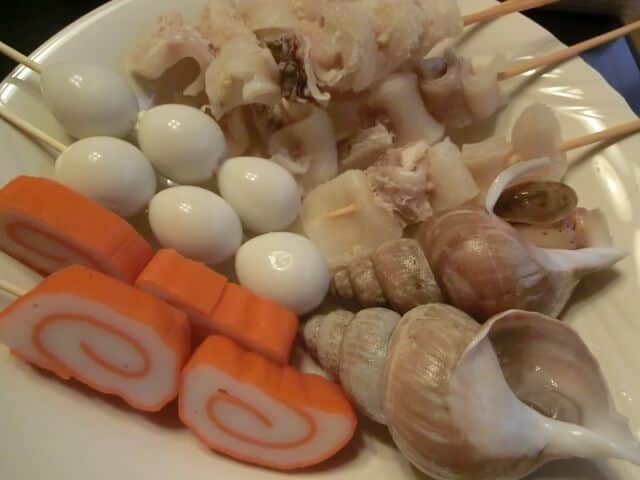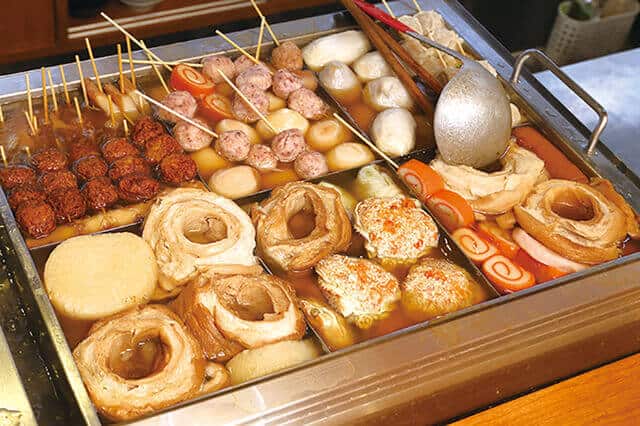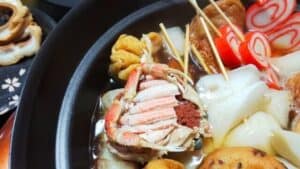With its unique blend of ingredients and distinct simmering broth, Kanazawa oden is a true reflection of the local culinary traditions and rich heritage of the region. From the tender daikon radish to the savory fish cakes and delicate flavors of the soy-based broth, every bite tells a story of tradition and craftsmanship. If you’re curious to learn more about the secrets behind this beloved dish and explore the intricate flavors of this oden, join us in delving deeper into the article. Get ready to satisfy your curiosity and ignite your passion for Japanese cuisine.
What is Kanazawa oden?

Kanazawa oden is a traditional Japanese dish that originates from the city of Kanazawa in Ishikawa prefecture. It is popular for its unique flavors and ingredients, reflecting the local culinary traditions of the region. The dish typically features a variety of ingredients, such as daikon radish, boiled eggs, konnyaku (a gelatinous yam cake), chikuwa (fish cakes), and various types of fish and shellfish. What sets Kanazawa oden apart is the distinct broth used for simmering the ingredients. Locals typically made this from a blend of soy sauce, dashi (a traditional Japanese stock made from kombu seaweed and bonito flakes), and other seasonings. The broth is carefully prepared to achieve a delicate balance of umami flavors.
Kanazawa oden History

The origin of Kanazawa Oden is closely connected to the broader origin of Oden in Japan. Oden itself is a traditional Japanese dish enjoyed for centuries throughout the country. The roots of Oden can be traced back to the Edo period (1603-1868) in Japan. During this time, street food vendors began selling various ingredients simmered in soy-based broths to customers seeking warm and nourishing meals. This simple yet satisfying style of cooking became popular, and Oden gradually gained recognition as a staple dish in Japanese cuisine.
Kanazawa Oden, specifically, emerged as a regional variation of Oden in the city of Kanazawa. As the local culinary traditions developed in Kanazawa, the city’s unique flavors and ingredients influenced the preparation of Oden. This hearty dish showcases the local ingredients and culinary techniques specific to the region, adding its distinct character to the traditional dish. The dish’s popularity grew within Kanazawa and its surrounding areas, where it became a beloved local specialty. This dish stands out with its carefully crafted broth, blending soy sauce, dashi (traditional Japanese stock made from kombu seaweed and bonito flakes), and other seasonings to create a delicate balance of umami flavors.
What are the key ingredients used in Kanazawa Oden?

Interestingly, despite being a winter dish, locals serve oden in many Kanazawa restaurants all year round. In fact, although oden is a hot pot cuisine filled with various kinds of fish paste, this dish is famous for using unique local products such as fu or wheat gluten, and bai-Gai. Furthermore, Kanazawa Oden’s staple ingredient is related to Kanazawa, such as kuruma-fu (wheat gluten), plum shells, puffed fish, and Kaga vegetables such as Gensuke radish.
Plum Shell

“Umegai” is a conch commonly eaten in the Hokuriku region. In Kanazawa, they often used this as an ingredient in oden, and you can enjoy its crunchy texture and concentrated flavor.
Wheat Gluten

Kuruma-fu is made by wrapping nama-fu around a stick and grilling it. If you take a bite, you will not be able to get enough of the flavor of the soup stock that overflows.
Kani-men (Stuffed crab shell)

A long-established oden restaurant (Kikuichi) in Kanazawa City is bustling with people looking for Kanazawa Oden’s staple ingredient which is kani-men. This restaurant made kani-men by filling the shell with crab miso and legs of the female Kobako crab, which is a snow crab and used as an ingredient in oden. Interestingly, at a long-established oden restaurant in the center of Kanazawa, many people lined up to try the kani-men even before it opened. Notably, this kani-men is only available during the cold season or during winter, which means this is also a unique kind of Kanazawa oden.
How do locals prepared the broth for Kanazawa Oden?

Locals prepare Kanazawa Oden broth for its unique flavor, starting with simmering kombu and katsuobushi. They make dashi, a traditional Japanese stock rich in umami, then add soy sauce. Optional seasonings like mirin or sake enhance the taste, and the mixture is gently simmered. Some variations may incorporate ingredients like ginger or garlic during simmering for added complexity. The resulting broth, the soul of the dish, infuses it with distinct, delicious flavors.
Kanazawa oden FAQ
- What is the best time of year to enjoy Kanazawa Oden in Kanazawa?
-
Indeed, Kanazawa Oden is best enjoyed during colder months, particularly autumn and winter in Kanazawa. Kanazawa’s cold, snowy winters make this warm, hearty dish an ideal choice. Seek out a local oden-ya or izakaya to savor the delightful flavors of this oden.
Kanazawa oden Recipe

Kanazawa oden Ingredients
| Ingredients of Kanazawa oden for 2 persons | Measurements |
|---|---|
| Japanese white radish | 200g |
| Wheat gluten | 30g |
| Steamed octopus (leg) | 50g |
| Egg | 46g |
| Thread konjac | 20g |
| Deep-fried fish cake | 35g |
| Ganmodoki | 40g |
| Tsumire | 22g |
| Ⓐ Soup stock | 500g |
| Ⓐ Light soy sauce | 28g |
| Ⓐ Mirin | 28g |
How to make Kanazawa oden?
Peel the radish, cut into 3cm-thick slices, chamfer them, make a cross cut on the back, and parboil them. Soak the kuruma-fu in plenty of water for about 30 minutes to rehydrate and drain. Place the steamed koto, thread konjac, and kneaded product on a colander and pour boiling water over it. Boil the eggs and peel them.
Add all the Ⓐ to a pot and bring to a boil. Add the pre-boiled daikon radish and simmer over low heat for about 30 minutes.
Take it in a bowl and eat it with a sauce that you want (either mustard).
Where to try Kanazawa oden?
Oden Izakaya Miyuki (おでん居酒屋 三幸)

It is a popular backstreet shop packed with customers every night. Their chicken stock base has an elegant color and a strong flavor. All of their oden is soaked in such dashi and they made with carefully selected ingredients.
Kikuichi (菊一)

It is the oldest store in Kanazawa and the birthplace of Kanazawa Oden’s signboard, crab mask (kani-men). Since its founding, Ohno has continuously added and improved their soy sauce-based bonito kelp dashi. In addition, they only offer kani-men for Kanazawa Oden during winter. Therefore, you can enjoy the taste of “Kanazawa style”, which is distinct from both Kanto style and Kansai style.
Amatsubo Kakinokibatake Main Store (あまつぼ柿木畠本店)

This restaurant is popular for its transparent dashi stock made only from kombu seaweed, bonito, salt, and sake. The umami of the ingredients is added to the simple and unassuming dashi, attracting visitors. It is also popular for having a wide variety of local sake that is perfect for both parties.
Takeaway

Kanazawa Oden is a true gem of Japanese culinary heritage, with its rich history, unique flavors, and careful preparation. If you ever get the opportunity to visit Kanazawa or if you simply have an interest in exploring the wonders of Japanese cuisine, immersing yourself in the world of oden is a truly delightful experience. We hope that this article has piqued your curiosity and motivated you to discover the pleasures of this dish, which will undoubtedly result in creating cherished memories and moments of culinary happiness along the way.
You can check some Japanese oden that we know you would like to try too.
















Comments